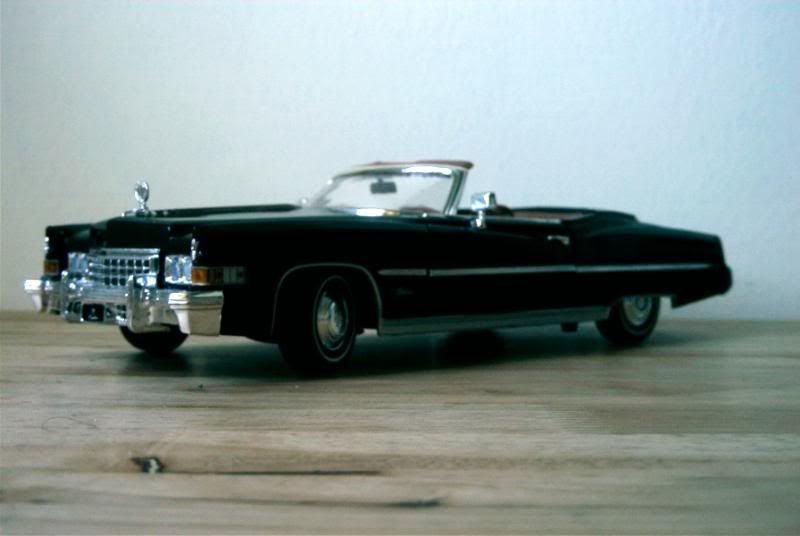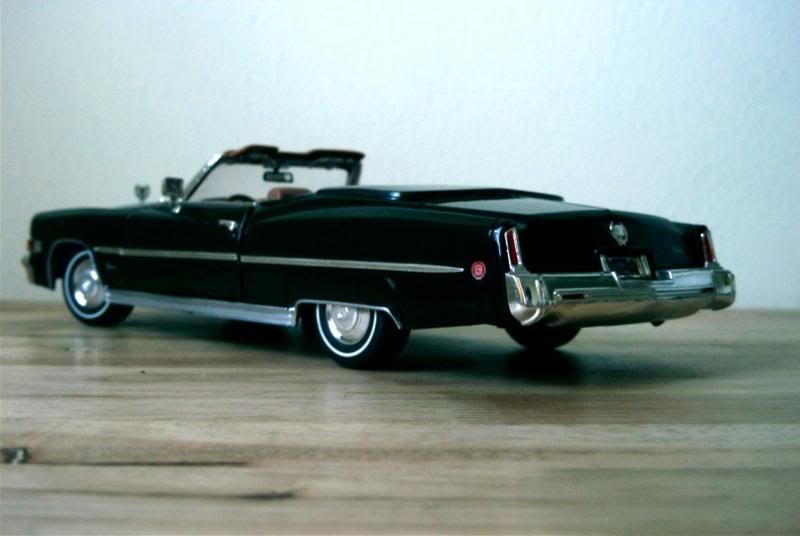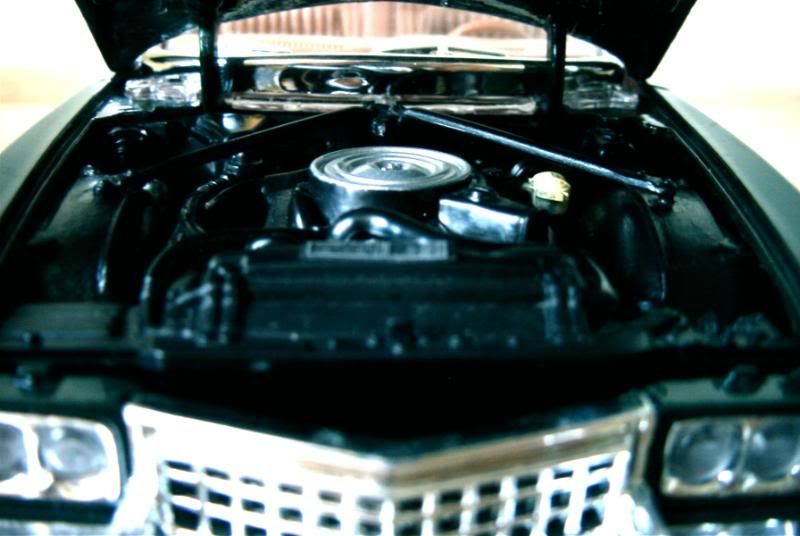A little history
The Buick Riviera initiated a new class of cars, named “personal luxury coupes”, when it was launched in 1962. Three years later, it was joined by the Oldsmobile Toronado, which added the originality of front-wheel-drive, guaranteeing excellent handling to these powerful but heavy automobiles. For model year 1967, with no true competitor yet on this market, General Motors unveiled Cadillac’s version of the personal luxury coupe, the brand-new Eldorado.
Though the nameplate existed for the last fifteen years, up to then the Eldorado had always been closely related to the rest of the luxury carmaker’s range. The 1967 model would be totally different.
Based on the Toronado’s platform, the Eldorado retained its front-wheel-drive architecture, a first at Cadillac’s. Transmission was through a standard Turbo-Hydramatic gearbox. The engine was initially the same “429” (7.0-litre) which powered the rest of the range, but by 1970 the Eldorado’s displacement had been gradually raised to 500 cu.in. (8.2-litre) for 400 bhp, giving quite a load of muscle to the behemoth.
Styling, in which Bill Mitchell’s influence was visible, was neat and angular, without any visual clue connecting it to the other cars proposed by Cadillac. The Eldorado had been slightly downsized. Quad headlights were now horizontal and, when not in use, hidden behind the grille. Fender skirts disappeared for a lighter look. Furthermore, there was no 1967 Eldorado convertible – only a coupe, its long and low lines stretching over the pavement, was offered.
Despite a hefty price and the 1968 appearance of a worthy competitor, the Lincoln Continental Mark III, the Eldorado sold well. Despite this success, life expectancy was short in Detroit during those days, and a new Eldorado appeared for model year 1971. Though still a distinct car, its style could be now much easily related to other Cadillacs: visible quad headlights, vertical fins at the end of the rear wings, fender skirts and vinyl roof were all present, alongside a resurrected convertible. This somewhat plainer Eldorado sold equally well nonetheless but, by 1976, the American automotive landscape was about to be radically modified. Cadillac had already announced that the Eldorado convertible, condemned by changing trends and growing concern about security, would be the last of its kind. Gone too after that year was the huge 8.2-litre, replaced by a 7.0-litre which, in those times of gasoline scarcity, was only reasonable by comparison. Besides, the Eldorado would become some sort of dinosaur after 1976, when the rest of the range was downsized. This survivor’s final extinction came two years later, when a diet Eldorado was introduced for model year 1979. Sadly, the new vehicle retained only a part of the old car’s weight, but also a fraction of its glamour.
About the model
Model: Cadillac Fleetwood Eldorado
Year: 1973
Maker: Anson
Scale: 1/18 (apparently adjusted to the size of the box, see below...)
Distributed by: Anson
Acquired: brand new, in July 2003, in Brive, France
I once read a raving review of this model in a magazine. Are journalists receiving backhanders to write such nonsense or are some of them simply blind, I cannot say. I bought this model – fortunately discounted – in France. As soon as I put it onto its shelf when back in the Philippines, and therefore had a base for comparison, I noticed something was wrong. Time to look for the Eldorado’s dimensions, to measure my die-cast, and then to make a little computation and the deception was clear: Anson’s Eldorado isn’t in 1/18 scale, despite what can be written on the box, but in a perfect 1/21. As a result I got rid off this odd car by offering it to another collector not so strict about scale as I am… Quality was correct – nothing exceptional though – but the aforementioned little trick, annoying when credited to toy-maker New Ray but totally unacceptable from Anson, deserves a 7/20. Sorry for the poor quality of the pictures, which were taken years ago and, obviously, cannot be renewed any more.





The Buick Riviera initiated a new class of cars, named “personal luxury coupes”, when it was launched in 1962. Three years later, it was joined by the Oldsmobile Toronado, which added the originality of front-wheel-drive, guaranteeing excellent handling to these powerful but heavy automobiles. For model year 1967, with no true competitor yet on this market, General Motors unveiled Cadillac’s version of the personal luxury coupe, the brand-new Eldorado.
Though the nameplate existed for the last fifteen years, up to then the Eldorado had always been closely related to the rest of the luxury carmaker’s range. The 1967 model would be totally different.
Based on the Toronado’s platform, the Eldorado retained its front-wheel-drive architecture, a first at Cadillac’s. Transmission was through a standard Turbo-Hydramatic gearbox. The engine was initially the same “429” (7.0-litre) which powered the rest of the range, but by 1970 the Eldorado’s displacement had been gradually raised to 500 cu.in. (8.2-litre) for 400 bhp, giving quite a load of muscle to the behemoth.
Styling, in which Bill Mitchell’s influence was visible, was neat and angular, without any visual clue connecting it to the other cars proposed by Cadillac. The Eldorado had been slightly downsized. Quad headlights were now horizontal and, when not in use, hidden behind the grille. Fender skirts disappeared for a lighter look. Furthermore, there was no 1967 Eldorado convertible – only a coupe, its long and low lines stretching over the pavement, was offered.
Despite a hefty price and the 1968 appearance of a worthy competitor, the Lincoln Continental Mark III, the Eldorado sold well. Despite this success, life expectancy was short in Detroit during those days, and a new Eldorado appeared for model year 1971. Though still a distinct car, its style could be now much easily related to other Cadillacs: visible quad headlights, vertical fins at the end of the rear wings, fender skirts and vinyl roof were all present, alongside a resurrected convertible. This somewhat plainer Eldorado sold equally well nonetheless but, by 1976, the American automotive landscape was about to be radically modified. Cadillac had already announced that the Eldorado convertible, condemned by changing trends and growing concern about security, would be the last of its kind. Gone too after that year was the huge 8.2-litre, replaced by a 7.0-litre which, in those times of gasoline scarcity, was only reasonable by comparison. Besides, the Eldorado would become some sort of dinosaur after 1976, when the rest of the range was downsized. This survivor’s final extinction came two years later, when a diet Eldorado was introduced for model year 1979. Sadly, the new vehicle retained only a part of the old car’s weight, but also a fraction of its glamour.
About the model
Model: Cadillac Fleetwood Eldorado
Year: 1973
Maker: Anson
Scale: 1/18 (apparently adjusted to the size of the box, see below...)
Distributed by: Anson
Acquired: brand new, in July 2003, in Brive, France
I once read a raving review of this model in a magazine. Are journalists receiving backhanders to write such nonsense or are some of them simply blind, I cannot say. I bought this model – fortunately discounted – in France. As soon as I put it onto its shelf when back in the Philippines, and therefore had a base for comparison, I noticed something was wrong. Time to look for the Eldorado’s dimensions, to measure my die-cast, and then to make a little computation and the deception was clear: Anson’s Eldorado isn’t in 1/18 scale, despite what can be written on the box, but in a perfect 1/21. As a result I got rid off this odd car by offering it to another collector not so strict about scale as I am… Quality was correct – nothing exceptional though – but the aforementioned little trick, annoying when credited to toy-maker New Ray but totally unacceptable from Anson, deserves a 7/20. Sorry for the poor quality of the pictures, which were taken years ago and, obviously, cannot be renewed any more.








No comments:
Post a Comment